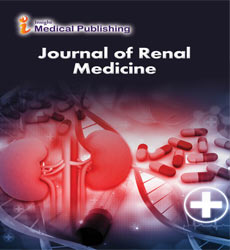Renal Osteodystrophy in Chronic Kidney Disease
Risa Shibuya*
Department of Medicine, Nihon University, Fujisawa, Japan
- *Corresponding Author:
- Risa Shibuya
Department of Veterinary Medicine, Nihon University, Fujisawa,
Japan,
E-mail: shibuya@yahoo.com
Received date: April 05, 2024, Manuscript No. IPJRM-24-19157; Editor assigned date: April 08, 2024, PreQC No. IPJRM-24-19157 (PQ); Reviewed date: April 22, 2024, QC No. IPJRM-24-19157; Revised date: April 29, 2024, Manuscript No. IPJRM-24-19157 (R); Published date: May 06, 2024, DOI: 10.36648/ipjrm.7.03.21
Citation: Shibuya R (2024) Renal Osteodystrophy in Chronic Kidney Disease. Jour Ren Med Vol. 7 No.03: 21.
Description
Renal osteodystrophy is a term used to describe a group of bone disorders that occur as a result of Chronic Kidney Disease (CKD). Renal osteodystrophy is a complex and multifactorial condition that arises as a consequence of chronic kidney disease. It poses significant challenges in terms of diagnosis and management, requiring a comprehensive approach that addresses mineral imbalances, hormonal abnormalities, and bone health. With early detection and appropriate treatment, the progression of renal osteodystrophy can be slowed, improving the quality of life for affected individuals. Close collaboration between nephrologists, endocrinologists, and other healthcare providers is essential to optimize patient outcomes and reduce the burden of this debilitating condition.
Renal osteodystrophy
Renal osteodystrophy primarily develops in individuals with CKD, especially those in the advanced stages where kidney function is significantly impaired. The kidneys play a crucial role in maintaining the balance of minerals such as calcium and phosphorus in the bloodstream. However, in CKD, the kidneys are unable to effectively regulate these minerals, leading to abnormalities in bone metabolism. One of the key mechanisms underlying renal osteodystrophy is the dysregulation of Parathyroid Hormone (PTH) secretion. As kidney function declines, there is a decrease in the activation of vitamin D, which leads to a drop in calcium levels in the blood. In response, the parathyroid glands secrete more PTH, a hormone that stimulates the release of calcium from the bones. Chronic elevation of PTH levels contributes to bone resorption and the development of osteitis fibrosa cystica, a severe form of renal osteodystrophy characterized by bone pain and pathological fractures. In addition to PTH dysregulation, CKD also disrupts the balance of other hormones involved in bone metabolism, such as calcitriol (active form of vitamin D) and Fibroblast Growth Factor 23 (FGF23). These hormonal imbalances further exacerbate the abnormalities in mineral metabolism, leading to the development of renal osteodystrophy. The symptoms of renal osteodystrophy can vary depending on the severity of the bone abnormalities and may include bone pain, particularly in the lower back, hips pain, legs pain, bone fractures, which may occur spontaneously or as a result of minimal trauma, bone deformities, such as bowed legs or curvature of the spine (scoliosis).
Diagnosis and treatment
Diagnosing renal osteodystrophy typically involves a combination of clinical evaluation, laboratory tests, and imaging studies. Healthcare providers will assess the patient's medical history, symptoms, and risk factors for CKD-related bone disorders. Laboratory tests play a crucial role in evaluating mineral metabolism and hormonal imbalances associated with renal osteodystrophy. Serum calcium and phosphorus level abnormalities in these minerals are common in individuals with CKD and may indicate bone disorders. Parathyroid Hormone (PTH) levels elevated PTH levels are often observed in renal osteodystrophy due to secondary hyperparathyroidism. Vitamin D levels reduced levels of calcitriol are frequently observed in CKD, contributing to bone abnormalities. Alkaline Phosphatase (ALP) levels elevated ALP levels may indicate increased bone turnover associated with renal osteodystrophy. In addition to laboratory tests, imaging studies such as X-rays, bone density scans like Dual-Energy X-Ray Absorptiometry (DEXA), and bone biopsies may be performed to assess bone structure and density. The management of renal osteodystrophy aims to alleviate symptoms, prevent complications such as fractures, and optimize bone health. Treatment strategies often involve a combination of pharmacological interventions, dietary modifications, and lifestyle changes. The specific approach may vary depending on the severity of the condition and individual patient factors. Restriction of dietary phosphorus limiting the intake of phosphorus-rich foods, such as dairy products, nuts, and processed foods, can help control phosphorus levels in the blood. Adequate protein intake consuming sufficient protein is essential for maintaining muscle mass and bone health, but it is important to choose high-quality protein sources with lower phosphorus content. Weight-bearing exercises, such as walking or strength training, can help improve bone density and muscle strength, reducing the risk of fractures. Smoking has been associated with accelerated bone loss and increased fracture risk, so quitting smoking is important for overall bone health. Taking measures to prevent falls, such as removing tripping hazards at home and using assistive devices as needed, can help reduce the risk of fractures, especially in older adults. In some cases, surgical interventions such as parathyroidectomy like surgical removal of the parathyroid glands may be considered for individuals with severe secondary hyperparathyroidism refractory to medical treatment.
Open Access Journals
- Aquaculture & Veterinary Science
- Chemistry & Chemical Sciences
- Clinical Sciences
- Engineering
- General Science
- Genetics & Molecular Biology
- Health Care & Nursing
- Immunology & Microbiology
- Materials Science
- Mathematics & Physics
- Medical Sciences
- Neurology & Psychiatry
- Oncology & Cancer Science
- Pharmaceutical Sciences
